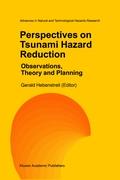- Start
- Perspectives on Tsunami Hazard Reduction: Observations, Theory and Planning
Perspectives on Tsunami Hazard Reduction: Observations, Theory and Planning
Angebote / Angebote:
The promontory of Gargano in the southern Adriatic Sea represents one of the most interesting Italian coastal zones subjected to tsunami hazard. Figure la gives the geographical map of Italy, with a box embracing the region of Gargano, details of that region are in turn sketched in Figure lb. Because of the incompleteness of the earthquake and tsunami catalogues, no reports on tsunamis in this area are available prior to 1600 AD. The Gargano events have been recently revised in order to establish their reliability and to attain the phenomenological reconstruction of the tsunamis (Guidoboni and Tinti, 1987 and 1988, Tinti et. al. , 1995). This work fits the general purpose of assessing tsunami hazard along the Italian coasts and represents a continuation of a previous study, where the first quantitative description of the 1627 tsunami from a numerical modeling viewpoint was performed (Tinti and Piatanesi, 1996). The earthquake took place on 30 July 1627 about mid-day and was followed by four large aftershocks. It claimed more than 5, 000 victims and destroyed completely numerous villages in the northern Gargano area, with the most severe damage located between S. Severo and Lesina. The earthquake excited a tsunami with the most impressive effects in proximity of the Lesina Lake where the most reliable contemporary chronicles report about an initial sea water withdrawal of about 2 miles and a subsequent penetration inland.
Folgt in ca. 15 Arbeitstagen
